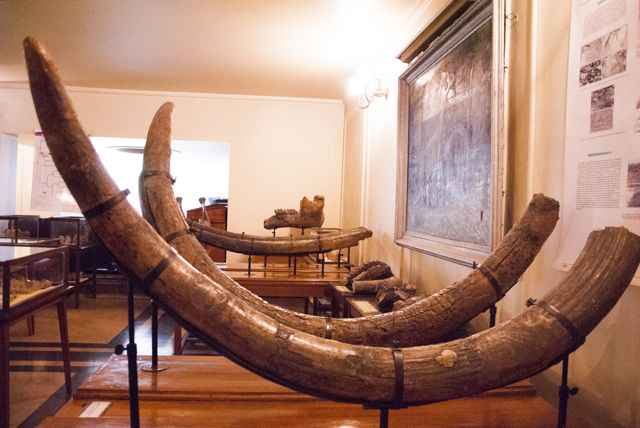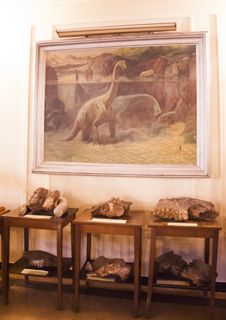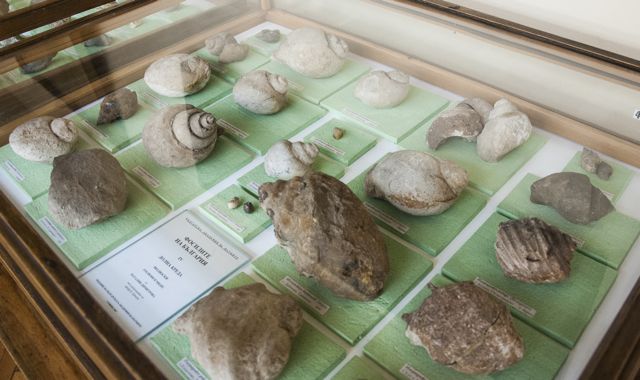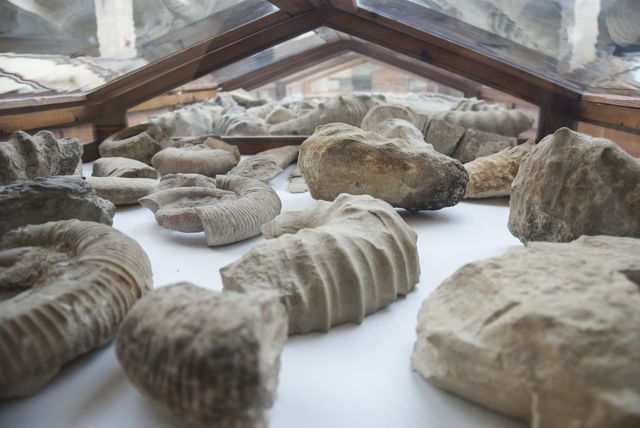Photos: Polina Spartyanova
Polina Spartyanova
One of the many mysteries of Sofia University "St. Kliment Ohridski" is a mammoth’s cousin that "inhabits" the area under its dome, in the northern wing of the Museum of Palaeontology and Historical Geology. It is a representative of the Deinotherium family and the scientific circles believe that this is the only fully preserved skeleton of this type of mammal in the world, as it is composed of well-preserved original bones. The Deinotherium skeleton is seven metres long and around four metres high, and its worn-out teeth show that, probably, the animal was middle-aged, between 40 and 45 years old. The Deinotherium is related to both modern elephants and extinct mastodons, the difference between them being the size and direction of their tusks. The Deinotherium disappeared at the end of the last "ice age", about 11,000 years ago, and is still in the top three of the largest mammals that ever walked on Earth.

The first Bulgarian paleontological collections date back to the beginning of the last century and include findings from a number of fossils that are widely spread in Bulgaria. They were collected from teachers and students at Sofia University during their exercises, field trips and thematic fieldwork. Later, in the 1930s and 1940s, many young geologists, while working on their doctoral theses, donated new fossils and lithological samples to the Museum, which was yet to be formed. Thus the Museum of Palaeontology and Historical Geology, in addition to its direct purpose to assist the educational process, became a place where specialists and amateurs from Bulgaria and abroad could see the achievements of Bulgarian palaeontology.
 The central place in it is assigned to the pride of Bulgarian palaeontologists, the Deinotherium, along with the fossils of other mammals exposed in the same hall. Here you can see even skulls and jaws of extinct species such as Hipparions, a genus of horse. Most of the fossils of dozens of animals that inhabited these lands a few million years ago such as proboscid giants with huge tusks, Mammuthus, Anancus, Tetralophodon, available to the museum are exhibited too as well as the remains of bears and gazelles, and the conditions, reasons and natural laws relating to their evolution and emerging biological problems. Predators such asthe sabre-toothed tiger, giraffe and monkey stand out among Neogene representatives.
The central place in it is assigned to the pride of Bulgarian palaeontologists, the Deinotherium, along with the fossils of other mammals exposed in the same hall. Here you can see even skulls and jaws of extinct species such as Hipparions, a genus of horse. Most of the fossils of dozens of animals that inhabited these lands a few million years ago such as proboscid giants with huge tusks, Mammuthus, Anancus, Tetralophodon, available to the museum are exhibited too as well as the remains of bears and gazelles, and the conditions, reasons and natural laws relating to their evolution and emerging biological problems. Predators such asthe sabre-toothed tiger, giraffe and monkey stand out among Neogene representatives.
The exhibition also includes a rich collection of fossils of invertebrates and plant matter from the Palaeozoic era to the Quaternary era, carefully arranged in wooden cabinets. Two different exhibitions, namely of palaeontology and historical geology, are arranged on a geo-chronological and evolutionary, and thematic basis. The 23 cabinets contain a palaeontology collection of the main fossil invertebrates and plant matter from the Palaeozoic era to the Quaternary era. The historical geology exhibition contains rock samples and fossils, and geological maps. Here is the only collection of geological maps in Bulgaria, containing all such maps relating to the Bulgarian lands, printed at home and abroad. The majority of the exhibits consist of marine fossils because, most of the time, today's territory of Bulgaria was the bottom of an ocean, due to which no remains of dinosaurs can be found in this region.

Today the collection of the Museum of Palaeontology and Historical Geology is continuing to grow thanks to the students of palaeontology at Sofia University. The teachers from the Department of Geology, Palaeontology and Fossil Fuels at the University along with their students often carry out planned field studies both in Bulgaria and abroad. In this way, young people are given the opportunity not only to enter into the depths of one of the most important sciences of plant and animal life, but also to contribute towards exploring past geological epochs.

Although the majority of people are more interested in the history of mankind than in that of the biological world and its development, there are visitors to the Museum. Here you can meet a lot of students who are trying to unravel the legend of the mammoth, which is right above the not so interesting lecture halls.